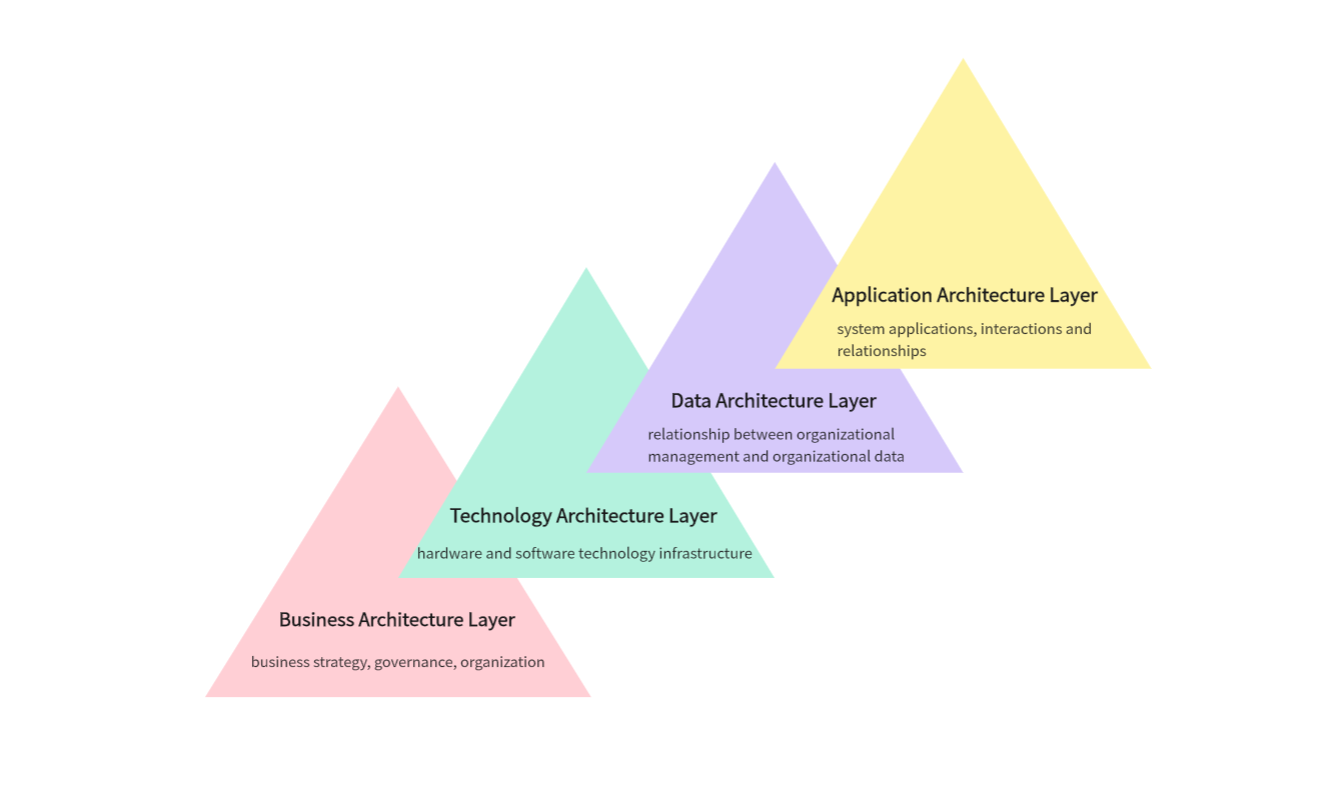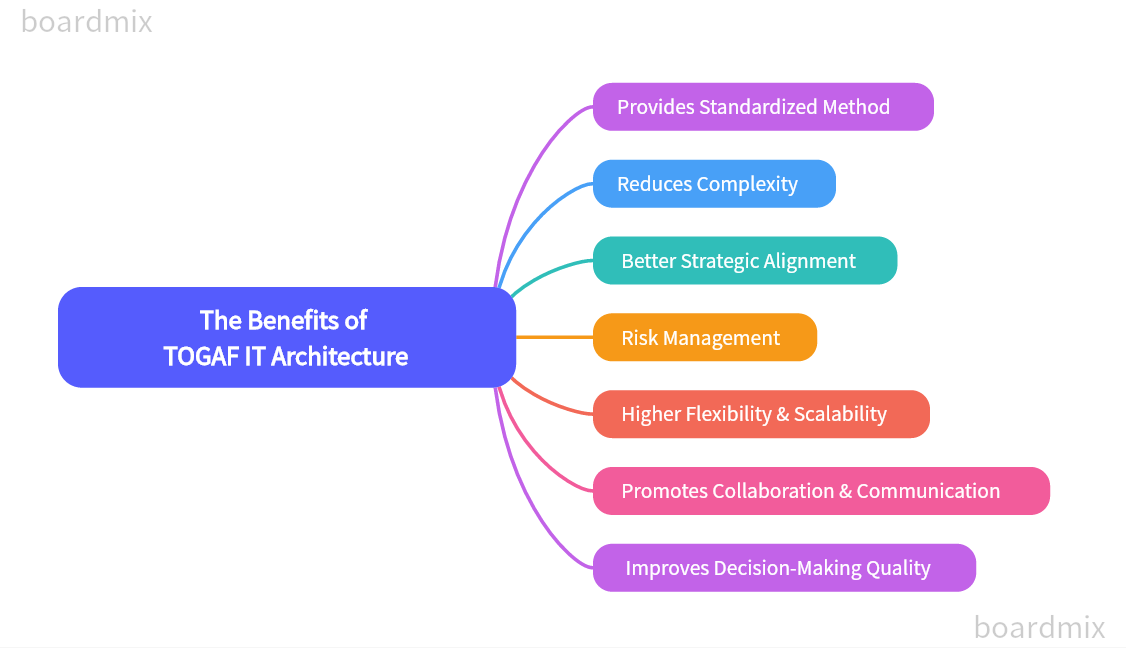What Is the TOGAF Model of Architecture?
The TOGAF model of architecture, also known as the TOGAF Architecture Development Method (ADM), is a framework that provides a structured approach to developing and implementing enterprise architecture. It consists of a set of guidelines, best practices, and processes that help organizations create and manage their IT architecture. The TOGAF ADM is divided into several phases, each focusing on different aspects of architecture development.

1. Preliminary Phase
In this phase, the organization defines the scope and objectives of the architecture development process. It involves establishing the architecture principles, governance framework, and organization structure for managing the architecture.
2. Architecture Vision Phase
This phase focuses on creating a high-level vision for the architecture. It involves identifying the business goals, drivers, and constraints that will shape the architecture. The outcome of this phase is the Architecture Vision document, which serves as a roadmap for the rest of the architecture development process.
3. Business Architecture Phase
In this phase, the organization defines the business processes, capabilities, and information requirements that support the business goals. It involves analyzing the current state of the business and identifying areas for improvement. The outcome of this phase is the Business Architecture document, which provides a blueprint for aligning the IT architecture with the business strategy.
4. Information Systems Architecture Phase
This phase focuses on defining the logical and physical architecture of the information systems. It involves identifying the application components, data models, and technology platforms that will support the business processes. The outcome of this phase is the Information Systems Architecture document, which describes how the information systems will be structured and integrated.
5. Technology Architecture Phase
In this phase, the organization defines the technology infrastructure that will support the information systems. It involves selecting the hardware, software, and network components that are needed to implement the architecture. The outcome of this phase is the Technology Architecture document, which outlines the technology standards, guidelines, and specifications.
6. Opportunities and Solutions Phase
This phase focuses on identifying potential solutions to address the gaps and challenges identified in the previous phases. It involves evaluating different options and selecting the most appropriate solution for each business requirement. The outcome of this phase is the Opportunities and Solutions document, which provides a detailed plan for implementing the architecture.
7. Migration Planning Phase
In this phase, the organization develops a detailed plan for implementing the architecture. It involves defining the sequence of implementation steps, estimating resource requirements, and identifying potential risks and issues. The outcome of this phase is the Migration Planning document, which serves as a roadmap for transitioning from the current state to the target state.
8. Implementation Governance Phase
This phase focuses on ensuring that the architecture is implemented according to the plan. It involves monitoring and controlling the implementation activities, managing changes and risks, and reviewing the progress against the established metrics. The outcome of this phase is a set of governance processes and procedures for managing the architecture implementation.
9. Architecture Change Management Phase
In this phase, the organization manages changes to the architecture over time. It involves monitoring the performance of the implemented architecture, identifying areas for improvement, and making necessary changes to address emerging business needs. The outcome of this phase is a set of processes and tools for managing architecture changes.
10. Architecture Requirements Management Phase
This phase focuses on managing the requirements for the architecture throughout its lifecycle. It involves capturing, documenting, and prioritizing the architecture requirements, as well as tracing them back to the business goals and objectives. The outcome of this phase is a set of requirements management processes and tools.
The TOGAF ADM provides a systematic approach to developing and managing enterprise architecture. By following this framework, organizations can ensure that their IT systems are aligned with their business goals and objectives. It helps in identifying areas of improvement, making informed decisions about technology investments, and driving organizational change.
What Are the TOGAF Layers on the IT Enterprise Architecture?
TOGAF IT Architecture is a widely used enterprise architecture development framework globally. In the TOGAF IT Architecture framework, enterprise architecture is divided into the following four levels.

1. Business Architecture Layer
This layer describes the business strategy, governance, organization, and key business processes of the enterprise. It provides business objectives and guiding principles for all other architectural layers so that they can support the strategic goals of the enterprise.
2. Data Architecture Layer
This layer describes the relationship between organizational management and organizational data as well as other related attributes. It helps organizations understand their data assets to better utilize these assets to support business objectives.
3. Application Architecture Layer
This layer describes system applications and their interactions and relationships. It provides application solutions for implementing specific business processes or functions.
4. Technology Architecture Layer
This layer describes the hardware and software technology infrastructure that supports applications, data, and business architectures. It defines how to configure hardware and software in various environments (such as servers, workstations, networks, operating systems, databases, etc.) to meet the business and application needs of enterprises.
Each level has a series of related elements such as principles, methods, models, and standards that need to be considered during the development process of enterprise architecture. Through this layered approach, TOGAF IT Architecture helps organizations clarify their IT environment at all levels to achieve their business objectives.
What Are the Benefits of TOGAF IT Architecture?
TOGAF IT Architecture is a globally recognized enterprise architecture framework for improving the design, planning, implementation, and management of enterprise architecture. Here are the main benefits of TOGAF IT Architecture.
1. Provides Standardized Method
TOGAF provides a standardized method for creating and implementing enterprise architecture. This can help organizations avoid "reinventing the wheel", save time and resources, and ensure the application of best practices.
2. Reduces Complexity
By providing a clear structure and process, TOGAF IT Architecture helps reduce the complexity of enterprise architecture. This makes it easier for all relevant parties to understand and manage the architecture, thereby improving work efficiency and quality.
3. Better Strategic Alignment
TOGAF emphasizes close alignment between business and IT. By identifying and clarifying business needs, and how to meet these needs through IT, TOGAF IT Architecture helps ensure that IT investments are closely aligned with corporate strategy.
4. Risk Management
TOGAF IT Architecture provides a framework for identifying and managing risks in enterprise architecture. This helps organizations identify potential problems earlier and take measures to prevent or minimize the impact of risks.
5. Higher Flexibility & Scalability
TOGAF IT Architecture is designed to adapt to changing needs and environments. This means it can support constantly evolving and changing organizations and can be expanded to meet new requirements or opportunities.
6. Promotes Collaboration & Communication
TOGAF encourages cross-departmental, cross-functional collaboration and communication. This helps break information silos ensuring all departments or teams move towards the same goal.
7. Improves Decision-Making Quality
By providing a global perspective along with rich/detailed information, 'TOGAF' enhances decision-making quality. This aids decision-makers in making more wise/informed decisions thereby enhancing the establishment's competitive advantage.
The application of 'TOGAF' aids establishments more effectively in realizing their 'Enterprise Architecture', supports commercial objectives, reduces risks, enriches work efficiency/quality as well as improves communication/collaboration.

How Is TOGAF Used in the IT Industry?
TOGAF IT Architecture is a widely adopted enterprise architecture method in the IT industry, which can be used for designing, planning, implementing, and managing enterprise architecture. Here are some specific applications of TOGAF in the IT industry.
1. Architecture Planning
In the planning phase of an IT project, TOGAF can help determine the architectural requirements of the project, identify related technologies, applications, and data resources, formulate the architectural blueprint of the project, and determine how to implement this blueprint. In this way, TOGAF can ensure that the architectural design of the project meets business needs and strategic objectives.
2. Architecture Design
In the design phase, TOGAF can provide a comprehensive set of methods and tools to help architects create and optimize an enterprise's application, data, and technology architectures. This includes creating architectural models, defining architectural principles and standards, selecting appropriate technologies and products, etc.
3. Architecture Implementation
In the implementation phase, TOGAF can provide a set of processes and guiding principles to help project teams implement projects according to pre-set architectural blueprints including application development, data management, and technology infrastructure configuration. TOGAF also provides a governance framework to ensure that project implementation complies with pre-set architectural requirements.
4. Architecture Governance
During the operation phase, TOGAF helps organizations monitor/manage the operation of enterprise architecture, identify, solve potential problems, and carry out necessary optimization, upgrades. TOGAF IT Architecture governance framework also helps organizations ensure their architecture always aligns with business needs/strategic objectives.
Overall, TOGAF is widely applied within the IT industry for planning, designing, implementing, managing Enterprise Architecture. With the TOGAF IT Architecture, organizations can improve ROI on their IT investments, increase work efficiency/quality, reduce risks, and better support their business objectives.













